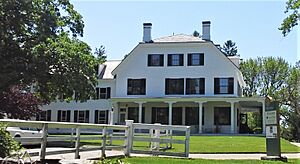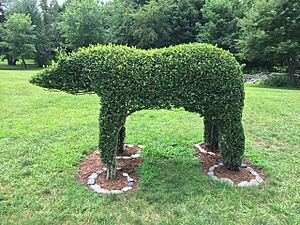Green Animals Topiary Garden facts for kids
The Green Animals Topiary Garden is in Portsmouth, Rhode Island. It is the oldest and most northern topiary garden in the United States. This 7-acre estate looks out over Narragansett Bay.
The garden has a huge collection of topiaries. These are plants shaped like sculptures. There are eighty sculptured trees. Some favorites include teddy bears, a camel, a giraffe, an ostrich, and an elephant. You can also spot two bears, pineapples, a unicorn, a reindeer, a dog, and a horse with its rider. These amazing shapes are made from California privet, yew, and English boxwood plants.
The garden also features over 35 flowerbeds and geometric pathways. There is a rose arbor, a grape arbor, fruit trees, and gardens for vegetables and herbs. A greenhouse helps grow many seedlings for the estate. The 1859 Victorian Brayton house is now a museum. It shows off old family furniture and a small display of vintage children's toys. Ribbons won for prize-winning dahlias and vegetables from around 1915 hang in the gift shop. The Preservation Society of Newport County takes care of the garden today.
Contents
History of the Garden
How Green Animals Began
In 1872, Thomas E. Brayton (1844–1939) bought this small country estate in Portsmouth. He was a treasurer for a company in nearby Fall River, Massachusetts. Mr. Brayton wanted a summer home away from the city. The property was 7 acres. It had a white summer house, farm buildings, a pasture, and a vegetable garden. The main Victorian home offered views of Narragansett Bay.
The Gardeners Who Shaped It
Joseph Carreiro was the superintendent of the property from 1905 to 1945. He slowly turned the estate into a place of living sculpture. Mr. Carreiro was hired to create and care for both pretty and edible gardens. The goal was to make the estate self-sufficient. Besides planting fruit trees and various gardens, Mr. Carreiro started shaping some fast-growing shrubs. The first topiaries began in the estate's greenhouse in 1912. They were later moved outside.
Mr. Brayton passed away in 1939. His daughter, Alice Brayton, moved into the house permanently in 1940. Joseph Carreiro was helped by his son-in-law, George Mendonca. Both gardeners were key to creating the topiaries. Mr. Mendonca was hired to fix the garden after a hurricane in 1938. He married Carreiro's daughter, Mary. They lived on the grounds, also overlooking Narragansett Bay. George and Mary Mendonca passed away just one day apart in February 2011.
Miss Brayton renamed the estate "Green Animals" because of their amazing work. Each topiary was carefully hand-trimmed and trained. This process took many decades. Today, some topiaries are trained on metal frames to make them grow faster. Under Miss Brayton's guidance, about 30 topiaries were created. For five decades, Mr. Mendonca's care helped the garden become a famous place for plants.
Challenges and Famous Visitors
Another hurricane hit the garden in 1954. The giraffe topiary lost its head and neck! It took five years for it to grow back, but with a much shorter neck.
The estate hosted a special party for Jackie Bouvier in 1947-48. She later married President John F. Kennedy. Her stepfather lived nearby in Newport. The estate also welcomed other important people, like Mamie Eisenhower, who was President Dwight Eisenhower's wife.
When Miss Brayton passed away in 1972 at age 94, she left Green Animals to The Preservation Society of Newport County. Mr. Mendonca continued to manage the grounds until he retired in 1985. Each year, Green Animals hosts a children's party. About 1,000 people attend this fun event.
Plant Information
Types of Plants Used
The oldest topiaries were started in 1912. They were shaped from boxwood (Buxus sempervirens) and California privet (Ligustrum ovalifolium). Boxwood is often used for topiaries, but Green Animals also uses a lot of privet.
Boxwood is a dense evergreen plant with small, dark green, shiny leaves. It grows slowly and likes shade. Its leaves can be damaged by very cold weather in northern areas. Some boxwood plants at the estate have a fungal infection. This is because the irrigation system sometimes keeps the soil too wet. The geometric shapes in the garden are made from boxwood. New types of boxwood are being tested to replace older ones.
Topiaries made in the 1940s continued to use California privet. Privet is a fast-growing shrub with dark green, oval leaves. It was used because it grew quickly. Since the estate was a summer home, it was not a problem that privet loses its leaves in the fall. Privet needs regular care, including weekly hand-trimming. Some hidden metal supports are placed inside the shapes to keep them stable in wind and snow.
Newer topiaries are made from English yew (Taxus baccata). This is a strong evergreen plant with needles. It only needs pruning once or twice a year. However, yew is dense and has many branches, making it harder to shape.
Garden Layout and Use
Paths and plants near the main house are more formal. Newer areas of the estate, developed in the 1970s, have more modern, free-form topiaries.
The grounds also have a small orchard, a cutting garden for flowers, a vegetable patch, and a gourd arbor. There is also a damask rose garden. Vegetables from the garden are grown as part of a community farm program. The fresh produce is given to the Rhode Island Food Bank.
The greenhouse starts flower seedlings in January and February. Vegetable seedlings begin in March. These young plants are then moved to cold frames over the next few months. Unlike most cold frames, the ones at Green Animals are not made of wood. They have concrete footings that go deep into the ground. Alice Brayton designed these special cold frames.
Gardeners of Green Animals
- Joseph Carreiro, Superintendent of Green Animals, 1905–1945
- George Mendonça, Superintendent of Green Animals, 1950–1985
- Ernest Wasson, Grounds Manager, 1985–1990
- Crisse Genga, Grounds Manager, 1990 to 2002
- Mary Ann Von Handorf, Gardener 1988–2002, Grounds Manager, 2002–2003
- Eugene Platt, Topiarist, 2002–2020
- James Donahue, Horticulturist, 2004–2014
- Dan Christina, Chief Horticulturist and Manager, 2014–March 2023
Documentary About the Garden
Fast, Cheap, and Out of Control is a 1997 documentary film by Errol Morris. One part of the film shows George Mendonça's work at Green Animals.
- Film synopsis
See also
 In Spanish: Jardín de topiaria de animales verdes para niños
In Spanish: Jardín de topiaria de animales verdes para niños




